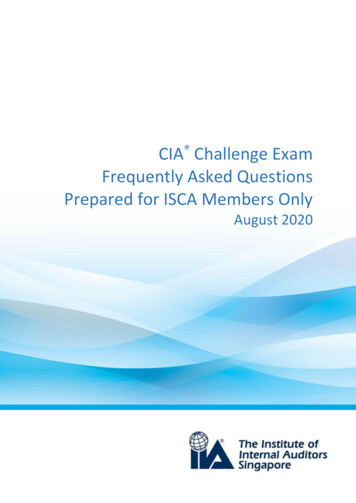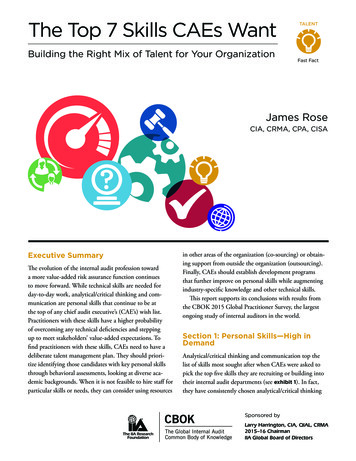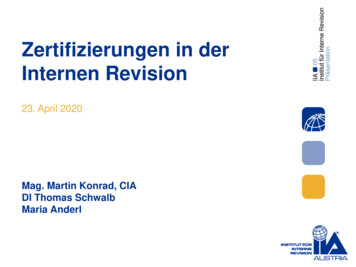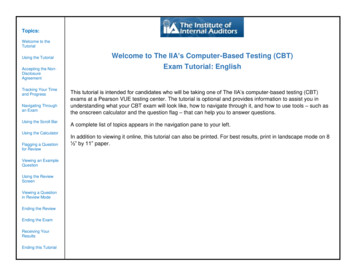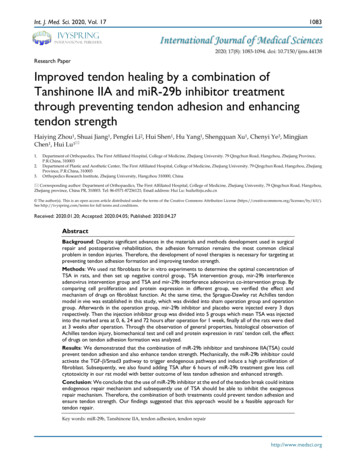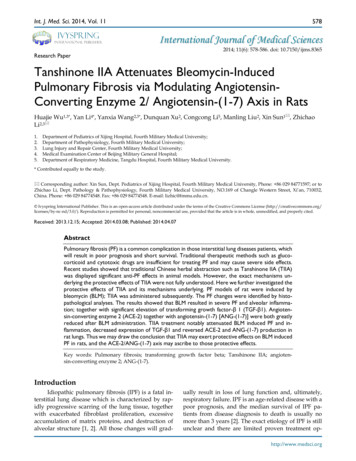
Transcription
Int. J. Med. Sci. 2014, Vol. 11IvyspringInternational Publisher578International Journal of Medical SciencesResearch Paper2014; 11(6): 578-586. doi: 10.7150/ijms.8365Tanshinone IIA Attenuates Bleomycin-InducedPulmonary Fibrosis via Modulating AngiotensinConverting Enzyme 2/ Angiotensin-(1-7) Axis in RatsHuajie Wu1,3*, Yan Li4*, Yanxia Wang2,3*, Dunquan Xu2, Congcong Li5, Manling Liu2, Xin Sun1 , ZhichaoLi2,3 1.2.3.4.5.Department of Pediatrics of Xijing Hospital, Fourth Military Medical University;Department of Pathophysiology, Fourth Military Medical University;Lung Injury and Repair Center, Fourth Military Medical University;Medical Examination Center of Beijing Military General Hospital;Department of Respiratory Medicine, Tangdu Hospital, Fourth Military Medical University.* Contributed equally to the study. Corresponding author: Xin Sun, Dept. Pediatrics of Xijing Hospital, Fourth Military Medical University, Phone: 86 029 84771597; or toZhichao Li, Dept. Pathology & Pathophysiology, Fourth Military Medical University, NO.169 of Changle Western Street, Xi’an, 710032,China. Phone: 86 029 84774548. Fax: 86 029 84774548. E-mail: lizhic@fmmu.edu.cn. Ivyspring International Publisher. This is an open-access article distributed under the terms of the Creative Commons License ). Reproduction is permitted for personal, noncommercial use, provided that the article is in whole, unmodified, and properly cited.Received: 2013.12.15; Accepted: 2014.03.08; Published: 2014.04.07AbstractPulmonary fibrosis (PF) is a common complication in those interstitial lung diseases patients, whichwill result in poor prognosis and short survival. Traditional therapeutic methods such as glucocorticoid and cytotoxic drugs are insufficient for treating PF and may cause severe side effects.Recent studies showed that traditional Chinese herbal abstraction such as Tanshinone IIA (TIIA)was displayed significant anti-PF effects in animal models. However, the exact mechanisms underlying the protective effects of TIIA were not fully understood. Here we further investigated theprotective effects of TIIA and its mechanisms underlying. PF models of rat were induced bybleomycin (BLM); TIIA was administered subsequently. The PF changes were identified by histopathological analyses. The results showed that BLM resulted in severe PF and alveolar inflammation; together with significant elevation of transforming growth factor-β 1 (TGF-β1). Angiotensin-converting enzyme 2 (ACE-2) together with angiotensin-(1-7) [ANG-(1-7)] were both greatlyreduced after BLM administration. TIIA treatment notably attenuated BLM induced PF and inflammation, decreased expression of TGF-β1 and reversed ACE-2 and ANG-(1-7) production inrat lungs. Thus we may draw the conclusion that TIIA may exert protective effects on BLM inducedPF in rats, and the ACE-2/ANG-(1-7) axis may ascribe to those protective effects.Key words: Pulmonary fibrosis; transforming growth factor beta; Tanshinone IIA; angiotensin-converting enzyme 2; ANG-(1-7).IntroductionIdiopathic pulmonary fibrosis (IPF) is a fatal interstitial lung disease which is characterized by rapidly progressive scarring of the lung tissue, togetherwith exacerbated fibroblast proliferation, excessiveaccumulation of matrix proteins, and destruction ofalveolar structure [1, 2]. All those changes will grad-ually result in loss of lung function and, ultimately,respiratory failure. IPF is an age-related disease with apoor prognosis, and the median survival of IPF patients from disease diagnosis to death is usually nomore than 3 years [2]. The exact etiology of IPF is stillunclear and there are limited proven treatment ophttp://www.medsci.org
Int. J. Med. Sci. 2014, Vol. 11tions. Current therapies such as anti-inflammatory,immunosuppressive, or anti-fibrotic methods showedno promising results to halt the progression of thedisease or to improve the quality of life [3]. Therefore,it is urgent to further investigate the pathophysiological mechanisms and explore novel therapeutic strategies for treating PF.Recent studies showed that renin angiotensinsystem (RAS) is involved in the progression of PFevidenced by angiotensinogen (AGT) genes polymorphism association with PF, and its overexpressionin those patients with PF [4, 5]. After cleaved by angiotensin converting enzyme (ACE), angiotensin(ANG) I turns into ANG II. The activated ANG IIanswers for up-regulating transforming growth factor-β (TGF-β) which is pivotal in modulating the differentiation of fibroblast to myofibroblasts [6]. Moreover, ANG II is also believed to associate with inflammatory responses and cell apoptosis during theprogress of various lung diseases [7, 8]. Recent discovery of a homologue of ACE, named ACE-2, and itsenzymatic product ANG-(1–7) could counter the detrimental effects of ACE and offer beneficial effects bylimiting ANGII accumulation during kinds of pathophysiological processes [9-11]. Studies also demonstrated that ACE-2/ANGA (1-7) plays a key negativeregulatory factor for severity of lung edema and acutelung failure [12, 13]. Recently, the protective effects ofACE-2/ANG-(1-7) during the progression of PF wereincreasingly being investigated [14-16].Our previous studies have shown that a traditional Chinese herbal abstraction, Tanshinone IIA(TIIA), exerted significant protective effects on lunginjury induced by lipopolysaccharide (LPS) and hypoxic hypertension [17, 18]. In the present study, weexplored TIIA’s protective effects by employing a PFmodel of rat, and the ACE-2/ANG-(1-7) axis was investigated. In the present study, TIIA was shown to beeffective on halting the development of PF, whichmay via the ACE-2/ANG-(1-7) axis. This study provided new insights into the mechanisms underlyingthe lung beneficial effects of TIIA and may offer newtargets for treating PF.Materials and MethodsExperimental groupsAll procedures involving animals were approved by the Animal Care and Use Committee of theFourth Military Medical University and compliedwith the Declaration of the National Institutes ofHealth Guide for Care and Use of Laboratory Animals(Publication No. 85-23, revised 1996). Male Sprague-Dawley rats (body weight 224 15 g) from theanimal center of the Fourth Military Medical Univer-579sity (Xi’an, China) were used for all the experiments inthis study. Rats were randomly divided into 1) controlgroup, n 10, 2) BLM group, n 10, and 3) BLM TIIAgroup, n 10, total 3 groups. After being anesthetized,the rats were weighted and BLM (Sigma Aldrich, St.Louis, MO) administered intratracheally at a dose of 5mg/kg, the volume of BLM was 50μl. TIIA (25mg/kg) was administered intraperitoneally daily until 28 days after BLM was given for 1 hour. Controlanimals were injected intratracheally with 50 μl ofsterile saline of 0.9%. BLM and saline was given foronly once.Lung coefficient analysesLung coefficient [weight of wet lung (mg) / bodyweight] is an index for evaluating lung edema. In aword, at the end of each time point (7 days, 14 days,and 28 days, separately), rats were anesthetized andsternotomy surgery was performed, and lungs werethen carefully obtained. After the lungs were cleanedwith cold PBS solution, the lungs were sipped by filterpaper and the lung coefficient was calculated. Part ofthe right lungs were cut for next histological assaysand the remained were maintained in a -80 freezerfor next analyses.Lung histological assaysAfter being taken out, the lungs were dissectedinto 3-mm-thick slices at the same part (the lower lobeof the right lungs) and fixed in 10% formaldehyde.Then the lungs were embedded in paraffin and sectioned into 4-μm-thick sections. Hematoxylin andeosin staining (HE) and Trichrome Masson’s stainingwere performed. Aiming to evaluate the collagen andfibrosis changes during PF, a modified picrosiriusprocedure based on the classic sirius red staining wasperformed [19, 20]. In brief, after regular deparaffinization and rehydration, the lung specimens wereimmersed in 1% phosphomolybdic acid for 5 min andthen covered with 0.1% (w/v) sirius red F3B (Sigma-Aldrich, St. Louis, MO, USA) in saturated picricacid solution for 1 h at room temperature. The specimens were mounted after being dehydrated andcleared in xylene. The specimens were analyzed byusing a light microscope (Olympus BX50, Tokyo, Japan) under normal and polarized light obtained withpolarizing filters (Olympus U-ANT, Tokyo, Japan) inorder to analyze the initial collagen organization andthen the fibrosis. The lung alveolar inflammation andPF were scaled by the HE staining and the TrichromeMasson’s staining as described by the previous studyof Szapiel [21]. Three independent pathologists undertook the histological examination and applied thescoring system in a blinded fashion.http://www.medsci.org
Int. J. Med. Sci. 2014, Vol. 11580Immunohistochemical staining analysesLung sections of 4-μm were prepared and deparaffinized, rehydrated, and blocked by incubatingin 0.3% H2O2 for 30 min. After antigen retrieval wasperformed the slides were incubated for 1 h withnormal goat serum, and then incubated with TGF-β1mouse monoclonal antibody, ACE-2 mouse monoclonal antibody, and ANG-(1-7) mouse monoclonalantibody (Santa Cruz Biotechnology Inc., Santa Cruz,CA, USA) at 4 overnight. After washed in phosphate buffered saline (PBS), the tissues were incubated with corresponding antibody for 30 min at 37 . Diaminobenzidine (DAB) signal detection methodwas performed for 8 min at room temperature. Negative controls were performed using mouse serum asthe primary antibody. Positive staining was colored indeep brown. All sections were evaluated using anOlympus BX50 optical microscope equipped with animage analysis program (Image Pro Plus version 6.0,Immagini e Computer, Milan, Italy) and analyzedquantitatively. The integrated optical density (IOD)was calculated for arbitrary areas, measuring in 10fields for each sample using a 40 objective.Western-blot assaysThe rat lung tissues were homogenated usingliquid nitrogen, and total lysates were obtained fromrat lung tissue by RIPA lysis buffer (Beyotime Inc,Jiangsu, China). Equivalent amounts of protein (30μg) of each sample were separated by electrophoresisusing 12% SDS-polyacrylamide gels. After beingtransferred onto 0.22 μM nitrocellulose filter membranes and blocked in 5% skimmed milk, the bandswere then incubated with the corresponding primaryantibodies (ACE-2, TGF-β).Reverse-transcription polymerase chainreaction (RT-PCR) investigationTotal RNA of rat lung tissue was extracted byusing Trizol agent (Invitrogen, Carlsbad, CA, USA).First-strand cDNA was synthesized by a M-MLV reverse transcripase kits (BestBio Inc, Shanghai, China)from 2.5 µg per sample of total RNA according to themanufacturer’s instructions. The primer pairs weredesigned by primer premier 5 (PREMIER Biosoft International, Palo Alto CA, USA), and original infor-mation of cDNA were aligned in the GeneBank. Theprimers were checked and synthesized by GenescriptCompany (Nangjing, China). The primer pairs forTGFβ1 are GAAGACATGACCCTGCTGGTGA (forward chain) and CTGGTGCTCTGGGCACTTGA (reversechain);ACE-2areAATCGTAGGCTCTGGGCTTGG (forward chain)and TTCGATCAACTGGTTTCGGTTGTA (reversechain).ELISA assaysThe concentrations of ANG-(1-7) in lung tissuewere measured using ELISA kits (R&D Systems Inc.,MN, USA) according to the manufacturer’s instructions.Statistical analysisData are expressed as mean SD, and statisticalanalysis was performed with analysis of variance(ANOVA). A statistical difference was accepted assignificant if P 0.05.ResultsTIIA treatment attenuated BLM-induced lunginjury, inflammation, and pulmonary fibrosisAccording to the evaluating scale, BLM exposureresulted in significant drop of rat weight, and notableincrease of lung coefficient compared to that of control group (* P 0.05, Table 1). However, TIIA treatment significantly reversed the drop of weight andincrease of lung coefficient of rats (# P 0.05 vs BLMgroup, Table 1).The HE staining showed that intact and clearalveoli, normal interstitium, few inflammatory cellswere observed in the lungs of control group at eachtime point (Fig. 1). However, BLM administrationcaused progressive lung injury, demonstrating as destruction of lung alveoli, inflammatory cells infiltration, and thickening of lung interstitium with timeextension (** P 0.01 vs Control group, Table 2 andFig. 1). TIIA treatment prevented those changes in ratlungs of administered with BLM (# P 0.05 vs BLMgroup, Table 2 and Fig. 1).Table 1. Changes of weight and lung coefficient between each group of rat. * P 0.05 vs Control group; #P 0.05 vs BLM group.ControlBLMBLM TIIAWeight (g)7d181 8.59173 8.03*175 7.28#14d219 6.34180 9.76*205 8.54#28d245 7.23192 8.01*220 7.33#Lung coefficient (mg/g)7d14d3.62 0.133.24 0.214.55 0.24*7.34 0.45*3.45 0.19#5.05 0.33#28d4.08 0.278.56 0.39*5.89 0.56#http://www.medsci.org
Int. J. Med. Sci. 2014, Vol. 11581Table 2. Alveolar inflammation and pulmonary fibrosis changes analyses. **P 0.01 vs Control group; # P 0.05 vs BLM group.ControlBLMBLM TIIAAlveolar inflammation7d14d0.00 0.000.05 0.0082.51 0.20**4.15 0.51**1.63 0.09#2.54 0.43#28d0.03 0.0076.75 0.49**3.07 0.21#Pulmonary fibrosis7d0.04 0.0051.04 0.18**0.83 0.07#14d0.06 0.0033.94 0.37**2.45 0.19#28d0.03 0.0015.42 0.32**3.42 0.27#Figure 1. Histopathological changes of lung tissue of rats in different group at different time (HE staining, 200). BLM bleomycin; TIIA tanshinone IIA. Scale bars 50μm.The Trichrome Masson’s staining also showedthat intact alveoli, normal interstitium in the lungs ofcontrol group at each time point (Fig. 2). BLM administration resulted in gradually exacerbated lungalveoli destruction, interstitium thickening, and fibroblasts diffusion in rat lungs (** P 0.01 vs Controlgroup, Table 2 and Fig. 2), and TIIA treatment significantly halted those changes in rat lungs after BLMadministration at each time point (# P 0.05 vs BLMgroup, Table 2 and Fig. 2).The sirius red staining exhibited that most of thecollagen fibers was type I (stained in orange to redcolor), and very few type III collagen fibers (stained inyellow to green color) was found in the rat lungs ofcontrol group (Fig. 3). There were no significantchanges between each time point. However, BLMresulted in more and more accumulation of type IIIcollagen fibers all over the rat lungs with time elapsing (** P 0.01 vs Control group, Table 3 and Fig. 3),and TIIA treatment significantly alleviated thosechanges (# P 0.05 vs BLM group, Table 3 and Fig. 3).Table 3. Collegan contents analyses. **P 0.05 vs Control group;# P 0.05 vs BLM group.Collegan I7d14dControl 0.09 0.0 0.10 0.0081BLM0.22 0.0 0.54 0.02**7**BLM TI 0.16 0.0 0.33 0.0IA3#4#28d0.13 0.010.65 0.03**0.41 0.02#Collegan III7d14d0.05 0.0 0.07 0.009060.12 0.0 0.32 0.02**5**0.10 0.0 0.24 0.0024#28d0.08 0.0050.97 0.04**0.53 0.07#http://www.medsci.org
Int. J. Med. Sci. 2014, Vol. 11582Figure 2. Collagen desposition of lung tissue of rats in different group at different time (Masson staining, 200). BLM bleomycin; TIIA tanshinone IIA. Scale bars 50μm.Figure 3. Collagen fibers of lung tissue of rats stained with sirius red and observed by polarized light optics in different group at different time ( 200), Type I collagenfibers are detected as orange to red, whereas the type III collagen fibers appear yellow to green. BLM bleomycin; TIIA tanshinone IIA.http://www.medsci.org
Int. J. Med. Sci. 2014, Vol. 11TIIA treatment up-regulated ACE-2expression in rat lungs after BLMadministrationAs the immunohistochemical staining showedthat BLM resulted in significant decrease expressionof ACE-2 in rat lungs compared to those of controlgroup at the endpoint of 28 days (P 0.01, Fig. 4A, A’).TIIA treatment greatly up-regulated expression ofACE-2 in rat lungs versus that of BLM administeredgroup (P 0.01, Fig. 4A, A’).The protein levels of ACE-2 were further verifiedby WB assays. As the data showed that the proteinlevels of ACE-2 were dramatically lessened after BLMadministration (Fig. 4B). However, TIIA treatmentgreatly reversed the lowered ACE-2 expression (Fig.4B).Similar with the protein expression of ACE-2 inrat lungs, the mRNA level of ACE-2 was also notablydecreased after administration of BLM compared withthat of control group (P 0.05, Fig. 4C). However, TIIAtreatment significantly augmented the expression ofACE-2 mRNA in rat lungs (P 0.01, Fig. 4C).Tanshinone IIA treatment increasedANG-(1-7) protein expression in rat lungs afterBLM administrationBLM administration resulted in notable decreased ANG-(1-7) expression in rat lungs compared583with the control group at the endpoint of 28 days (*P 0.05, Fig. 5A, A’). Yet TIIA treatment obviouslyincreased expression of ANG-(1-7) after BLM administration (P 0.01, vs BLM group, Fig. 5A, A’).ELISA assays verified that BLM administrationcontributed decrease of ANG-(1-7) level in rat lungs(P 0.05, vs control group, Fig. 5B). However, TIIAtreatment reversed the decreased expression ofANG-(1-7) (P 0.01, vs BLM group, Fig. 5B).TIIA treatment decreased TGF-β1 expressionin rat lungs after BLM administrationBLM administration evidently increased theprotein levels of TGF-β1 compared with the controlgroup in rat lungs at the endpoint of 28 days (P 0.01,Fig.6A, A’); however, TIIA treatment significantlyreduced its expression (P 0.01, vs BLM group, Fig.6A, A’).The protein levels of TGF-β1 were further verified by WB assays. The data showed that the proteinlevels of TGF-β1 were dramatically elevated afterBLM administration (Fig. 6B). However, TIIA treatment greatly inhibited TGF-β1 expression (Fig. 6B).Similarly, BLM administration evidently increased themRNA level of TGF-β1 in rat lungs (P 0.01, vs controlgroup, Fig. 6C), and TIIA treatment significantly reduced its expression (P 0.05, vs BLM group, Fig. 6C).Figure 4. ACE2 immunohistochemical analysis of lung tissue of rats in different group at 28 days. (A) Expression of ACE2 determined by immunohistochemicalstaining with ACE2 antibody: (a) Control group (b) BLM group (c) BLM TIIA group. (A’): IOD values of ACE2 staining. * *P 0.01 vs control group, ## P 0.01 vs BLMgroup. (B): Representative WB assays of ACE2 protein expression in rat lungs of different group at 28 days. (C): ACE2 mRNA expression of lung tissue of rats indifferent group at 28 days, * P 0.05 vs control group, ## P 0.01 vs BLM group. IOD integrated optical density; BLM bleomycin; WB western blot; TIIA TIIA. Scalebars 50 μm.http://www.medsci.org
Int. J. Med. Sci. 2014, Vol. 11584Figure 5. Ang-(1-7) immunohistochemical analysis of lung tissue of rats in different group at 28 days. (A) Expression of Ang-(1-7) determined by immunohistochemical staining with Ang-(1-7) antibody: (a) Control group (b) BLM group (c) BLM TIIA group; (A’) IOD values of Ang-(1-7) staining. * P 0.05 vs control group,## P 0.01 vs BLM group. (B) ELISA assays of Ang-(1-7) protein expression of lung tissue of rats in different group at 28 days, * P 0.05 vs control group, ## P 0.01vs BLM group. IOD integrated optical density; BLM bleomycin; TIIA TIIA. Scale bars 50 μm.Figure 6. TGF-β immunohistochemical analysis of lung tissue of rats in different group at 28 day. (A) Expression of TGF-β determined by immunohistochemicalstaining with TGF-βantibody: (a) Control group (b) BLM group (c) BLM TIIA group; (A’) IOD values of TGF-β staining. ** P 0.01 vs control group, ## P 0.01 vs BLMgroup. (B) Representative WB assays of TGF-β protein expression in rat lungs of different group at 28 days. (C) TGF-β mRNA expression of lung tissue of rats indifferent group at 28 day, ** P 0.01 vs control group, # P 0.05 vs BLM group. IOD integrated optical density; BLM bleomycin; WB western blot; TIIA TIIA. Scalebars 50 μm.http://www.medsci.org
Int. J. Med. Sci. 2014, Vol. 11DiscussionIn the present study we examined the protectiveeffects of TIIA on a BLM induced PF model of rats.BLM administration resulted in progressive and significant inflammation, exacerbated fibrosis, and severe alveolar destruction in rat lungs. In addition,significant decrease of ACE-2, ANG-(1-7), and elevation of TGF-β1 were also found in rat lungs after BLMexposure. However, TIIA treatment notably haltedBLM induced PF and inflammation, decreased exaggeration of TGF-β1, and reversed reduction of ACE-2and ANG-(1-7) in rat lungs. Overall, our results suggested a protective role of TIIA on BLM induced PF inrats. The ACE-2/ANG-(1-7) axis may answer for theprotective role of TIIA.PF is a common response to lung injuries induced by various etiologies. The etiologies includeIPF, acute respiratory distress syndrome (ARDS),sarcoidosis, and irradiation-related pneumonitis etc.Interstitial fibrosis is characterized by exaggerateddeposition of extracellular matrix proteins in the lung[22]. The endothelial and epithelial cells damages dueto the lung injury, accumulation of inflammatorycells, and the subsequent increasing production ofinflammatory mediators, all together promotes fibroblasts activation and proliferation during the pathogenesis of PF. PF induced exacerbated proliferation offibroblasts, connective tissue expansion, and alveolardestruction gradually lead to functional loss of lungs.Being an intractable disease, PF has a low survival time after diagnosis and no effective therapiestill today. With further understanding of this disease,recent aims for treating PF have shifted from reversing the development to slowing or halting the progression of this chronic fibrotic disease [23]. As is wellknown that TGF-β1 is amplified after lung injury, andplays a key promoter involved in the conversion offibroblasts to myofibroblasts, transformation of hymal transition), protection of myofbroblasts from apoptosis, and accumulation of collagenduring the progression of PF [24]. Studies havedemonstrated increased TGF-β1 levels in lungs afterBLM exposure [25, 26]. A monoclonal antibody hasbeen demonstrated to be effective in blocking murinefibrosis by partial inhibition of TGF-β1 without exacerbating inflammation [27]. Gene therapy methodshave revealed more choices for attenuating fibrogenesis by direct or indirect blocking TGF-β1 signalingpathway [28, 29]. In the present study, endotrachealinstillation of BLM induced a severe PF together witha dramatic increase of TGF-β1 expression, demonstrated as accumulation of interstitial lung collagen.Collagen deposition was obviously decreased by TIIAtreatment. In line with these studies, we also observed585increased lung mRNA levels of TGF-β1 after BLMinstillation, which was significantly reduced by TIIAtreatment.ACE-2, a homologue of ACE, was identified in2000, which finding evoked a new complexity to theRAS [30]. Despite the similar functions as ACE, ACE-2has different substrates [30, 31]. Previous studies revealed that ACE-2 may negatively regulate the RAS,and counterbalance the functions of ACE [32]. Another study also demonstrates ACE-2 plays a negativeregulatory role for severity of lung edema and acutelung failure [13]. Moreover, decreased pulmonaryACE-2 activity related with BLM induced lung injuryhas been reported in both animal and human studies[15, 33]. Our study showed that BLM induced decreased ACE-2 levels in rat lungs, which is consistentwith the previous studies. Moreover, TIIA treatmentreversed the lowered expression of ACE-2 levels bothby immunohistochemical and WB assays. Additionally, the mRNA levels of ACE-2 were also significantly lowered after BLM exposure, which is also inagreement with the study mentioned above.ANG-(1-7) is generated from a single residuecleaved by ACE-2 from ANG II [34], and thenANG-(1–7) could resist many of the effects of Ang IIand also potentiate bradykinin action and subsequentnitric-oxide-dependent vasodilation. Studies havedemonstrated that ANG-(1-7) and ACE-2 can reduceTGF-β1 levels in cultured fibroblast [35, 36]. Thus,methods of increasing ACE-2 or ANG-(1–7) expression may exert resisting effects on development of PF.Similar with the expression of ACE-2, the expressionof ANG-(1-7) also decreased after BLM treatment inthe current study. TIIA treatment significantly prevented the decrease of ANG-(1-7) expression, in thecompany of alleviation of collagen deposition andfibrosis.Recent studies have unfolded some promisingpharmaceutical drugs on treating PF [37, 38]. Ryo et alshowed that a newly developed drug, pirfenidone,exerts protective effects on patients withmild-to-severe and/or progressive IPF [39]. Thoughthere is a long way to go; we have seen the light beforeus.In summary, the present study further exploredthe protective effects and mechanisms of TIIA on PFmodels of rat. TIIA may exert protective effects onBLM induced PF, and the ACE-2/ANG-(1-7) axis mayanswer for those protective effects. The present studymay further our knowledge and offer basic information for clinical treating strategies on PF.AcknowledgementsThis study was supported by the National Natural Science Foundation of China (No. 81270328 andhttp://www.medsci.org
Int. J. Med. Sci. 2014, Vol. 11No81200036), and the Open Project of the Key Laboratory of High Altitude Medicine (No. 2011JSGY02).Competing InterestsThe authors have declared that no competinginterest 15.16.17.18.19.20.21.22.Gross TJ, Hunninghake GW: Idiopathic pulmonary fibrosis. N Engl J Med 2001,345(7):517-525.Dempsey OJ, Miller D: Idiopathic pulmonary fibrosis. BMJ 2013, 347:f6579.Mahendran S, Sethi T: Treatments in idiopathic pulmonary fibrosis: time for amore targeted approach? QJM 2012, 105(10):929-934.Molina-Molina M, Xaubet A, Li X, Abdul-Hafez A, Friderici K, Jernigan K, FuW, Ding Q, Pereda J, Serrano-Mollar A et al: Angiotensinogen gene G-6Apolymorphism influences idiopathic pulmonary fibrosis disease progression.Eur Respir J 2008, 32(4):1004-1008.Uhal BD, Li X, Piasecki CC, Molina-Molina M: Angiotensin signalling inpulmonary fibrosis. Int J Biochem Cell Biol 2012, 44(3):465-468.Montes E, Ruiz V, Checa M, Maldonado V, Melendez-Zajgla J, Montano M,Ordonez-Razo R, Cisneros J, Garcia-de-Alba C, Pardo A et al: Renin is an angiotensin-independent profibrotic mediator: role in pulmonary fibrosis. EurRespir J 2012, 39(1):141-148.Okada M, Suzuki K, Matsumoto M, Takada K, Nakanishi T, Horikoshi H,Higuchi T, Hosono Y, Nakayama M, Ohsuzu F: Effects of angiotensin on theexpression of fibrosis-associated cytokines, growth factors, and matrix proteins in human lung fibroblasts. J Clin Pharm Ther 2009, 34(3):288-299.Santos-Silva MA, Pires KM, Trajano ET, Martins V, Nesi RT, Benjamin CF,Caetano MS, Sternberg C, Machado MN, Zin WA et al: Redox imbalance andpulmonary function in bleomycin-induced fibrosis in C57BL/6, DBA/2, andBALB/c mice. Toxicol Pathol 2012, 40(5):731-741.Kuba K, Imai Y, Penninger JM: Angiotensin-converting enzyme 2 in lungdiseases. Curr Opin Pharmacol 2006, 6(3):271-276.Lu J, Jiang T, Wu L, Gao L, Wang Y, Zhou F, Zhang S, Zhang Y: The expressionof angiotensin-converting enzyme 2-angiotensin-(1-7)-Mas receptor axis areupregulated after acute cerebral ischemic stroke in rats. Neuropeptides 2013,47(5):289-295.Xia H, Sriramula S, Chhabra KH, Lazartigues E: Brain Angiotensin-convertingenzyme type 2 shedding contributes to the development of neurogenic hypertension. Circ Res 2013, 113(9):1087-1096.Imai Y, Kuba K, Rao S, Huan Y, Guo F, Guan B, Yang P, Sarao R, Wada T,Leong-Poi H et al: Angiotensin-converting enzyme 2 protects from severeacute lung failure. Nature 2005, 436(7047):112-116.Kuba K, Imai Y, Rao S, Gao H, Guo F, Guan B, Huan Y, Yang P, Zhang Y, DengW et al: A crucial role of angiotensin converting enzyme 2 (ACE2) in SARScoronavirus-induced lung injury. Nat Med 2005, 11(8):875-879.Molteni A, Wolfe LF, Ward WF, Ts'Ao CH, Molteni LB, Veno P, Fish BL,Taylor JM, Quintanilla N, Herndon B et al: Effect of an angiotensin II receptorblocker and two angiotensin converting enzyme inhibitors on transforminggrowth factor-beta (TGF-beta) and alpha-actomyosin (alpha SMA), importantmediators of radiation-induced pneumopathy and lung fibrosis. Curr PharmDes 2007, 13(13):1307-1316.Li X, Molina-Molina M, Abdul-Hafez A, Uhal V, Xaubet A, Uhal BD: Angiotensin converting enzyme-2 is protective but downregulated in human andexperimental lung fibrosis. Am J Physiol Lung Cell Mol Physiol 2008,295(1):L178-L185.Meng Y, Yu CH, Li W, Li T, Luo W, Huang S, Wu PS, Cai SX, Li X: Angiotensin-Converting Enzyme 2/Angiotensin-(1-7)/Mas Axis Protects against LungFibrosis by Inhibiting the MAPK/NF-kappaB Pathway. Am J Respir Cell MolBiol 2013.Wang J, Dong MQ, Liu ML, Xu DQ, Luo Y, Zhang B, Liu LL, Xu M, Zhao PT,Gao YQ et al: Tanshinone IIA modulates pulmonary vascular response to agonist and hypoxia primarily via inhibiting Ca2 influx and release in normaland hypoxic pulmonary hypertension rats. Eur J Pharmacol 2010,640(1-3):129-138.Xu M, Cao F, Liu L, Zhang B, Wang Y, Dong H, Cui Y, Dong M, Xu D, Liu Y etal: Tanshinone IIA-induced attenuation of lung injury in endotoxemic mice isassociated with reduction of hypoxia-inducible factor 1alpha expression. Am JRespir Cell Mol Biol 2011, 45(5):1028-1035.Dayan D, Hiss Y, Hirshberg A, Bubis JJ, Wolman M: Are the polarizationcolors of picrosirius red-stained collagen determined only by the diameter ofthe fibers? Histochemistry 1989, 93(1):27-29.SWEAT F, PUCHTLER H, ROSENTHAL SI: SIRIUS RED F3BA AS A STAINFOR CONNECTIVE TISSUE. Arch Pathol 1964, 78:69-72.Szapiel SV, Elson NA, Fulmer JD, Hunninghake GW, Crystal RG: Bleomycin-induced interstitial pulmonary disease in the nude, athymic mouse. AmRev Respir Dis 1979, 120(4):893-899.Steele MP, Schwartz DA: Molecular mechanisms in progressive idiopathicpulmonary fibrosis. Annu Rev Med 2013, 64:265-276.58623. Adamali HI, Maher TM: Current and novel drug therapies for idiopathicpulmonary fibrosis. Drug Des Devel Ther 2012, 6:261-272.24. Goodw
the rats were weighted and BLM (Sigma Aldrich, St. Louis, MO) administered intratracheally at a dose of 5 mg/kg, the volume of BLM was 50μl. TIIA (25 mg/kg) was administered intraperitoneally daily un-til 28 days after BLM was given for 1 hour. Control animals were injected intratracheally with 50 μl of sterile saline of 0.9%.



